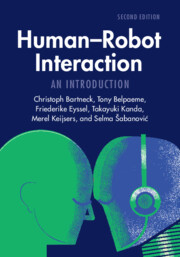Refine search
Actions for selected content:
1206 results in Computer Graphics, Image Processing and Robotics
8 - How People Perceive Robots
-
- Book:
- Human-Robot Interaction
- Published online:
- 13 June 2024
- Print publication:
- 27 June 2024, pp 134-147
-
- Chapter
- Export citation

Human-Robot Interaction
- An Introduction
-
- Published online:
- 13 June 2024
- Print publication:
- 27 June 2024
8 - Difference Equations with Nonzero IC
-
- Book:
- Signals, Systems, and Signal Processing
- Published online:
- 29 August 2024
- Print publication:
- 13 June 2024, pp 324-346
-
- Chapter
- Export citation
4 - Digital Filters and Filter Structures
-
- Book:
- Signals, Systems, and Signal Processing
- Published online:
- 29 August 2024
- Print publication:
- 13 June 2024, pp 117-162
-
- Chapter
- Export citation
2 - Fundamentals of Signals and Systems
-
- Book:
- Signals, Systems, and Signal Processing
- Published online:
- 29 August 2024
- Print publication:
- 13 June 2024, pp 10-61
-
- Chapter
- Export citation
Dedication
-
- Book:
- Signals, Systems, and Signal Processing
- Published online:
- 29 August 2024
- Print publication:
- 13 June 2024, pp v-vi
-
- Chapter
- Export citation
10 - Sampling a Continuous-Time Signal
-
- Book:
- Signals, Systems, and Signal Processing
- Published online:
- 29 August 2024
- Print publication:
- 13 June 2024, pp 410-457
-
- Chapter
- Export citation
9 - The Continuous-Time Fourier Transform
-
- Book:
- Signals, Systems, and Signal Processing
- Published online:
- 29 August 2024
- Print publication:
- 13 June 2024, pp 347-409
-
- Chapter
- Export citation
13 - The Laplace Transform
-
- Book:
- Signals, Systems, and Signal Processing
- Published online:
- 29 August 2024
- Print publication:
- 13 June 2024, pp 556-575
-
- Chapter
- Export citation
Index
-
- Book:
- Signals, Systems, and Signal Processing
- Published online:
- 29 August 2024
- Print publication:
- 13 June 2024, pp 692-698
-
- Chapter
- Export citation
Reviews
-
- Book:
- Signals, Systems, and Signal Processing
- Published online:
- 29 August 2024
- Print publication:
- 13 June 2024, pp ii-ii
-
- Chapter
- Export citation
Acknowledgments
-
- Book:
- Signals, Systems, and Signal Processing
- Published online:
- 29 August 2024
- Print publication:
- 13 June 2024, pp xxvi-xxvi
-
- Chapter
- Export citation
6 - The z-Transform and its Inverse
-
- Book:
- Signals, Systems, and Signal Processing
- Published online:
- 29 August 2024
- Print publication:
- 13 June 2024, pp 211-249
-
- Chapter
- Export citation
Preface
-
- Book:
- Signals, Systems, and Signal Processing
- Published online:
- 29 August 2024
- Print publication:
- 13 June 2024, pp xix-xxv
-
- Chapter
- Export citation
16 - Sampling Based on Sparsity*
-
- Book:
- Signals, Systems, and Signal Processing
- Published online:
- 29 August 2024
- Print publication:
- 13 June 2024, pp 626-637
-
- Chapter
- Export citation
17 - Mathematical Intricacies*
-
- Book:
- Signals, Systems, and Signal Processing
- Published online:
- 29 August 2024
- Print publication:
- 13 June 2024, pp 638-670
-
- Chapter
- Export citation
5 - Recursive Difference Equations
-
- Book:
- Signals, Systems, and Signal Processing
- Published online:
- 29 August 2024
- Print publication:
- 13 June 2024, pp 163-210
-
- Chapter
- Export citation
1 - Introduction and Overview
-
- Book:
- Signals, Systems, and Signal Processing
- Published online:
- 29 August 2024
- Print publication:
- 13 June 2024, pp 1-9
-
- Chapter
- Export citation
14 - State-Space Descriptions
-
- Book:
- Signals, Systems, and Signal Processing
- Published online:
- 29 August 2024
- Print publication:
- 13 June 2024, pp 576-600
-
- Chapter
- Export citation
7 - More on Digital Filters
-
- Book:
- Signals, Systems, and Signal Processing
- Published online:
- 29 August 2024
- Print publication:
- 13 June 2024, pp 250-323
-
- Chapter
- Export citation
